Bulletin – June 2016 Australian Economy Conditions in the Manufacturing Sector
- Download the article 329KB
Abstract
Manufacturing output and employment have fallen steadily as a share of the Australian economy for the past three decades. This article looks at the composition of the sector and draws on the Reserve Bank's liaison with manufacturers to provide an insight into some of their responses to the structural challenges in recent years. According to liaison, the increase in the supply of manufactured goods from low-cost sources abroad, exacerbated by the appreciation of the Australian dollar during the period of rising commodity prices, impaired the viability of many domestic manufacturers and precipitated the closure of some manufacturing production over the past decade. While the recent exchange rate depreciation has helped to improve competitiveness of Australian producers, so far there is only limited evidence of a recovery in manufacturing output and investment.
Introduction
The manufacturing sector in Australia has been on a relatively steady decline as a share of the overall economy for at least the past 30 years. It currently accounts for around 7 per cent of total output and employment. Over that period, domestic manufacturers have faced strong competition from an increase in supply from lower-cost economies, most notably China. Furthermore, over the 2000s, strong Asian demand for Australian commodities led to a sharp increase in the terms of trade and an appreciation of the Australian dollar. The high level of the exchange rate placed additional competitive pressure on manufacturers, adding to the pressures for structural change within the sector. This article draws on the Reserve Bank's business liaison program to illustrate the major challenges facing the sector and how manufacturers are responding.[1]
Manufacturing in Australia
Manufacturing output increased steadily throughout most of the 1990s before plateauing in the early 2000s; output today is around the same level it was just over a decade ago (Graph 1). Over the past two decades, the Australian economy as a whole has grown considerably, resulting in a marked decline in manufacturing output as a share of total output. Employment in manufacturing has also declined over the past two decades, with growth in labour productivity in line with that of the economy as a whole. While these trends have been evident for several decades, the period after the global financial crisis has been characterised by relatively slow growth of global industrial production, a more pronounced easing in output growth and fall in employment in the sector.
In line with these trends, investment in the manufacturing sector has also fallen steadily since its peak in 2005/06 (Graph 1). Survey measures and liaison suggest investment will fall further in the coming year.[2] The decline in the manufacturing sector's investment in machinery & equipment and non-dwelling construction has contributed to the recent weakness in private business investment (Kent 2014).
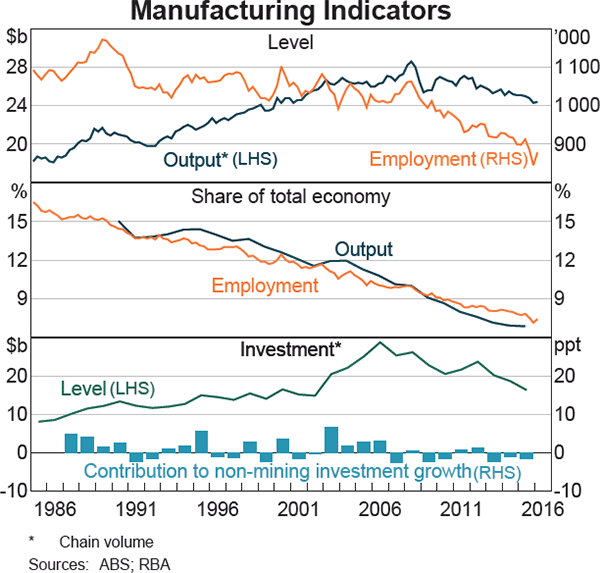
Australia's manufacturing sector is quite diverse and is comprised of several sub-industries, the largest being: food, beverage & tobacco; machinery & equipment; petroleum, coal & chemicals; and metal products (Graph 2). Together, these sub-industries account for around 80 per cent of manufacturing output and employment.
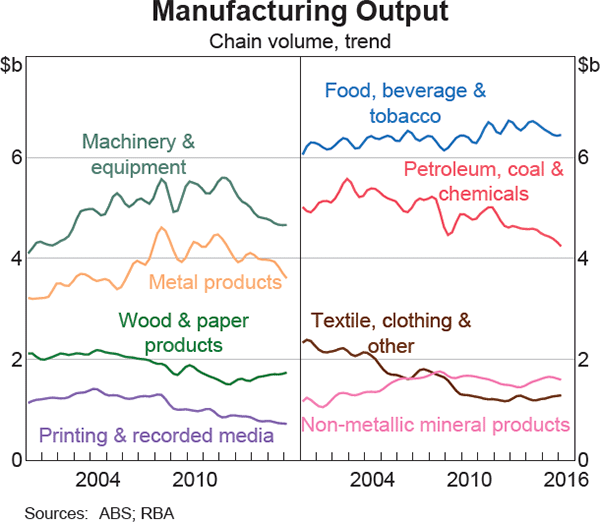
The ABS's input-output tables provide some insight into the structure of these sub-industries (Table 1). Among the four major sub-industries, two broad industry types emerge.
- The food, beverage & tobacco and metal products sub-industries both rely heavily on inputs from primary industries (agriculture and mining) where Australia has an abundant supply, and use a relatively low share of intermediate components that are imported. They also have lower-than-average exposure to competition from imports and tend to export more than other manufacturing sub-industries.
- Conversely, the machinery & equipment and petroleum, coal & chemicals sub-industries use relatively few inputs from primary industries in Australia and have a relatively high share of imported intermediate components. They are exposed to strong competition from imports and their final goods are geared primarily to the domestic market.
The International Context
The trends in Australian manufacturing output and employment are not unique. Over the past 25 years, most advanced economies have seen their manufacturing sectors recede as a share of both output and employment, although Australia has generally had a lower share than many other advanced economies (Graph 3).
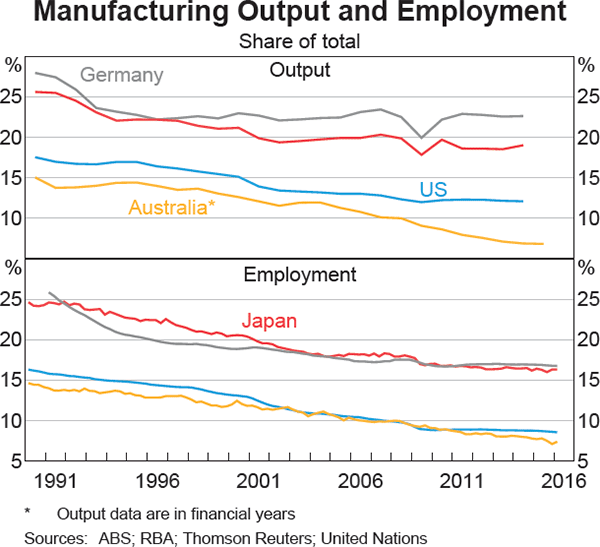
| Food, beverage & tobacco | Metal products | Machinery & equipment | Petroleum, coal & chemicals | Total manufacturing | |
|---|---|---|---|---|---|
| Share of manufacturing gross value added | 25 | 16 | 21 | 17 | |
| Share of manufacturing employment | 25 | 15 | 23 | 11 | |
| Domestic primary industry share of intermediate input | 38 | 50 | 0 | 13 | 27 |
| Imported share of intermediate input | 8 | 17 | 33 | 45 | 22 |
| Import penetration | 16 | 17 | 65 | 47 | 40 |
| Export share of supply | 17 | 35 | 5 | 9 | 13 |
| Value-added share of production | 29 | 20 | 37 | 27 | 29 |
|
Sources: ABS; RBA |
|||||
The ratio of value added to total production in the Australian manufacturing sector is broadly comparable to that in other advanced economies' manufacturing industries (Table 2). Relative to other Australian industries, manufacturing is a low value-added sector; the ratio of value-added to total production (29 per cent) is the lowest of any industry.
The observed trends in manufacturing output and employment in the advanced economies have been associated with the rise of competition from new sources. The most notable is China, which has increased its share of global manufacturing value-added from under 4 per cent in 1990 to just under 20 per cent in 2010, and increased its share of global exports of manufactured goods to around 18 per cent (OECD 2015; Graph 4). The steady increase in China's share of Australia's merchandise imports has coincided with a fall in the prices of imported manufactured goods relative to domestic production (Graph 4).
| US | 35 |
|---|---|
| UK | 35 |
| Japan | 31 |
| Germany | 30 |
| Australia(a) | 29 |
| Canada | 29 |
| China | 21 |
|
(a) 2012/13 Sources: ABS, European Commission; RBA |
|
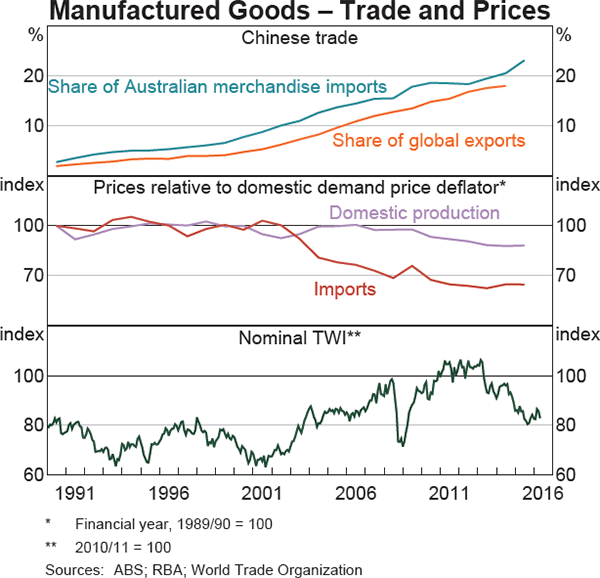
The Australian Dollar and Implications for Competitiveness
The appreciation of the Australian dollar from 2000 to 2013 worked against the international competitiveness of Australian manufacturing (Graph 4). Exports of Australian manufactured goods grew slowly over this period as they became relatively more expensive overseas (Graph 5). At the same time, Australian companies' propensity to import manufactured goods increased steadily due to a combination of greater purchasing power, a relatively low tariff structure and the emergence of cheaper suppliers of manufactured goods, most notably from China.
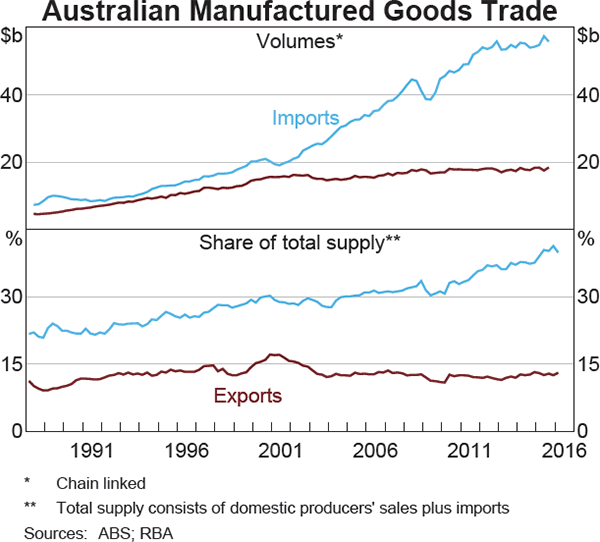
The Bank's liaison program suggests that one of the most notable responses by manufacturers to increased import competition and the higher value of the dollar was to move some or all of their production offshore. Typically, contacts maintain some productive capacity in Australia, either as a testing or research and development (R&D) facility, to protect their more sensitive intellectual property, or to be able to fill orders more quickly. Nevertheless, firms that have ‘offshored’ production typically have much less productive capacity remaining in Australia than their overseas operations. Offshoring decisions have also been motivated by concerns over labour costs and the prospect of better access to global supply chains and export markets, allowing firms to take advantage of greater economies of scale.
Since its peak in early 2013, the Australian dollar has depreciated by around 20 per cent on a trade-weighted basis. The associated improvement in international competitiveness has led to a slight increase in export volumes for some manufacturing sub-industries, most notably food, beverage & tobacco products. Nevertheless, the overall response has been fairly subdued to date.[3] To the extent that the prolonged appreciation of the dollar over the past decade caused domestic manufacturers to close or move production offshore, any export response to the more recent depreciation will be muted due to the significant fixed costs associated with reshoring or reopening production facilities.[4] Furthermore, liaison contacts have suggested that there are significant lags between a depreciation of the dollar and a response in manufacturing production and exports due to the nature of supply chains. For instance, even though domestic producers have become more competitive against imported products, retailers or other manufacturers may have contracts that secure supply in advance, which inhibits their ability to switch to domestically produced products.
Another consequence of the depreciation of the dollar is that a number of manufacturers now face higher input costs. Numerous contacts have reported that they responded to the appreciation of the dollar by importing more goods, either by choice or necessity as production of some inputs had moved offshore. In turn, following the more recent depreciation, these contacts have noted that while the lower value of the dollar aids demand, margins are under pressure due to rising import costs in instances where local substitutes are not readily available.
Domestic Input Costs and Implications for International Competitiveness
Beyond the influence of foreign competition and the exchange rate, domestic cost pressures, most notably labour costs, are often cited by liaison contacts as a challenge for the sector. Australian manufacturing labour costs appear to be relatively high compared with those in other economies – a feature that has become more pronounced over time (Graph 6). While some of the loss in Australian competitiveness over the period from 1997 to 2012 in US dollar terms was owed to the appreciation of the Australian dollar, nominal manufacturing labour costs increased by around 80 per cent in Australian dollar terms over this period, averaging 4 per cent per annum. Rising labour costs in foreign currency terms need to be offset by productivity gains in order to maintain international competitiveness. However, manufacturing productivity had not grown by enough in Australia to offset increasing domestic labour costs and the higher Australian dollar, resulting in a loss of competitiveness against other economies up to 2012 (OECD 2015).
Relatively high labour costs imply that the domestic industry has a comparative disadvantage in producing homogenous, labour-intensive goods. A common theme from liaison in recent years has been that firms have been looking to find labour productivity gains by automating some production processes. They have also been developing new products to diversify their offering. These shifts are borne out in the nature of firms' investments; increasingly, manufacturers are investing in intellectual property rather than physical capital (Graph 7). Investment in intellectual property, which is comprised largely of expenditure on computer software and R&D, has increased throughout the economy, although the growth in both levels and as a share of sectoral investment has been stronger in the manufacturing sector than most other industries.
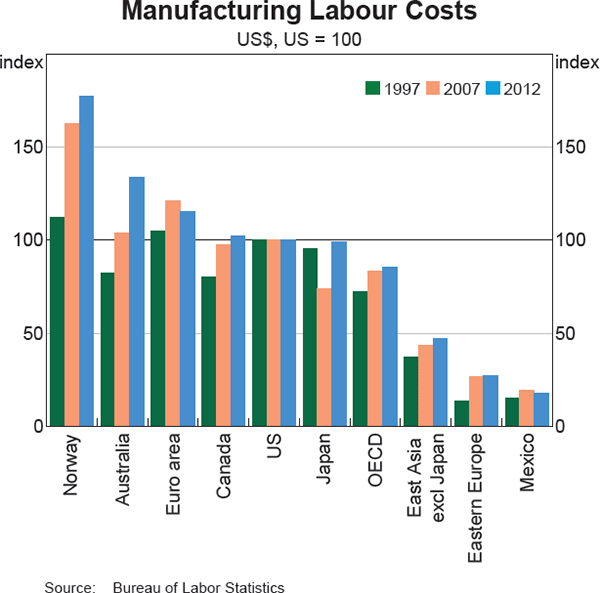
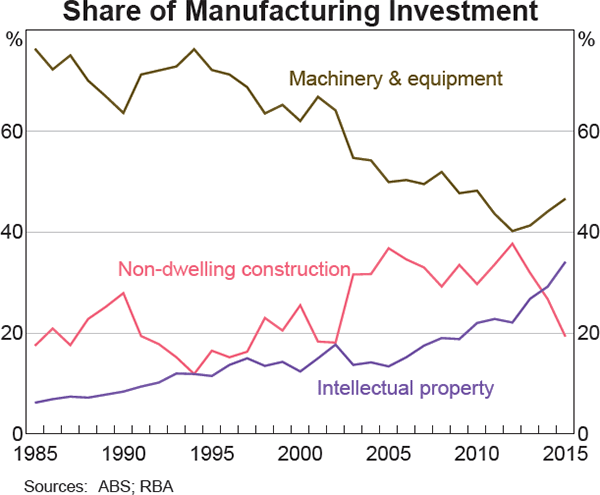
Liaison suggests that foreign-owned manufacturing firms operating in Australia are more willing to invest in R&D than physical capital in their Australian subsidiaries, although it is difficult to quantify what share of manufacturing activity is accounted for by these firms. Foreign investment in R&D appears to be in part driven by government tax incentives and Australia's reputation for possessing a highly educated workforce. In particular, the pharmaceutical and automotive industries are often identified as high quality, regional R&D hubs. Indeed, some automotive R&D operations are expected to remain in Australia beyond the cessation of passenger vehicle production.
While a number of liaison contacts' R&D remains geared toward adapting or localising foreign products for the Australian market, there are some instances of local companies with relatively high and constant R&D expenditure aimed at creating new, niche products. These operations tend to have a relatively small domestic workforce outside their engineering operations, with some or all production occurring offshore. This innovative, niche product business model is frequently highlighted by industry groups as the way forward for manufacturing in Australia. Businesses are being encouraged to try to capture more of the pre- and post-production work by offering before-and after-market services, such as design and customisation (Roos 2014).
Difficulties Integrating in Supply Chains
Another factor that has a bearing on the performance of the manufacturing sector is the economy's integration in global supply chains. Data on global supply chains suggest that other economies have responded to pressure from cheaper, imported manufactured goods by integrating themselves more effectively into increasingly fragmented global supply chains. For instance, most advanced economies saw an increase in the share of imported content in exports from 1995 to 2005; Australia did not (OECD 2015). Australia's geographic isolation contributes to high trade costs and presents a significant impediment to greater participation in global supply chains. Kelly and La Cava (2014) found that the costs of trading Australia's manufactured goods – largely international transport costs – are in the order of 20–25 per cent higher than the global average. Moreover, data from the ABS's Business Longitudinal Database show that only 4 per cent of manufacturing firms are part of an integrated supply chain.
In addition, Australia's relatively high trade costs leave domestic producers primarily exposed to the relatively small domestic market and unable to benefit from the scale advantages that other advanced economies achieve through production for larger domestic markets and export markets. Battersby (2006) finds that around 45 per cent of the difference between US and Australian non-farm labour productivity levels can be explained by Australia's geographic isolation. High trade costs may also protect less productive domestic firms from import competition, although this protection is likely to have been eroded through time by lower international search and transaction costs. Australian firms' relative isolation is also borne out by data on collaboration between firms; Australian companies are much less reliant on international partners for collaborative opportunities than are firms in other advanced economies (OECD 2011).
Conclusion
The depreciation of the Australian dollar over recent years has helped to improve the competitiveness of Australian manufacturing. Additionally, there is likely to be a steady level of activity in the food, beverages & tobacco sub-industry due to Australia's comparative advantage in primary resources and growing export demand. Against this, softer demand from the mining sector and the cessation of passenger vehicle production will weigh on output, although motor vehicle and transport equipment production currently makes up only around 5 per cent of manufacturing output.
In the longer term, the structural challenges facing the Australian manufacturing sector are likely to constrain output. Declining global prices for manufactured goods and the sustained high level of the Australian dollar during the resource investment boom impaired the viability of many Australian manufacturers and precipitated considerable structural change in the sector, with numerous manufacturers either closing or shifting production to lower-cost economies. R&D operations are one area where Australia's cost disadvantages are less of an impediment and our highly skilled workforce is a comparative advantage. Although R&D investment has been growing steadily, the subsequent demand for labour and, in particular, physical capital are likely to be less than was generated by ‘traditional’ manufacturing activities.
Footnotes
The author is from Economic Analysis Department. [*]
The Reserve Bank business liaison team conducts around 70–80 discussions with contacts on a monthly basis. Discussions with any individual firm typically occur around every 6 to 12 months. Bank staff usually meet the chief executive officer, chief financial officer and/or operations manager. Liaison meetings are held with firms of all sizes, although most discussions are with mid-sized and large firms where conditions are more likely to reflect economy-wide trends rather than firm-specific factors. For more information, see RBA (2014). [1]
The Australian Bureau of Statistics' (ABS) capital expenditure survey excludes investment in intellectual property, which has been growing at a faster pace than aggregate manufacturing investment for some time. [2]
See Cole and Nightingale (forthcoming) for further discussion. [3]
A situation whereby a sharp increase in foreign demand for commodities from one industry leads to an appreciation of the exchange rate and loss of competitiveness for another industry is commonly known as ‘Dutch Disease’. Downes, Hanslow and Tulip (2014) estimate that the level of manufacturing output in 2013 was around 5 per cent lower than it would have been in the absence of the mining investment boom. [4]
References
Battersby B (2006), ‘Does Distance Matter? The Effect of Geographic Isolation on Productivity Levels’, OECD Economic Studies, 2006(1), pp 205–225.
Cole D and S Nightingale (forthcoming), ‘Sensitivity of Australian Trade to the Exchange Rate’, RBA Bulletin.
Downes P, K Hanslow and P Tulip (2014), ‘The Effect of the Mining Boom on the Australian Economy’, RBA Research Discussion Paper No 2014-08.
Kelly G and G La Cava (2014), ‘International Trade Costs, Global Supply Chains and Value-Added Trade in Australia’, RBA Research Discussion Paper No 2014-07.
Kent C (2014), ‘Non-Mining Business Investment – Where to from Here?’, Speech to the Bloomberg Economic Summit, Sydney, 16 September.
OECD (Organisation for Economic Co-operation and Development) (2011), ‘International Collaboration on Innovation’, in OECD Science, Technology and Industry Scoreboard 2011, OECD Publishing, Paris.
OECD (2015), ‘Australian Manufacturing in the Global Economy’, study for the Australian Government, Department of Industry, Innovation, Science, Research and Tertiary Education.
RBA (Reserve Bank of Australia) (2014), ‘The RBA's Business Liaison Program’, RBA Bulletin, September, pp 1–5.
Roos G (2014), ‘The Constantly Changing Manufacturing Context’, in Advanced Manufacturing; Beyond the Production Line, CEDA, Melbourne, pp 31–56.